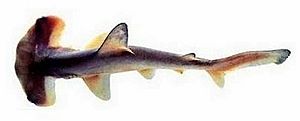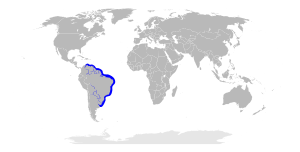Smalleye hammerhead shark facts for kids
Quick facts for kids Smalleye hammerhead shark |
|
|---|---|
 |
|
| Conservation status | |
| Scientific classification | |
| Kingdom: | |
| Phylum: | |
| Class: | |
| Subclass: | |
| Order: | |
| Family: | |
| Genus: | |
| Species: |
S.tudes
|
 |
|
| Map of where the smalleye hammerhead shark is found (In blue) | |
The smalleye hammerhead shark (Sphyrna tudes) is a small type of hammerhead shark. People also call it the "golden hammerhead" or the "curry shark". It lives in the shallow coastal waters of the western Atlantic Ocean. You can find it from Venezuela all the way down to Uruguay. This shark loves to live in muddy places. Like all hammerhead sharks, it has a special "hammer" shape on its head. This hammer is also called a "cephalofoil."
Contents
What Does It Look Like?
The smalleye hammerhead shark is one of the smaller hammerhead sharks. It can grow up to 1.5 meters (about 5 feet) long. However, most of them are usually around 1.2 to 1.3 meters (about 4 feet) long. They weigh about 9 kilograms (20 pounds).
Its Unique Head Shape
The "hammer" on its head, called a cephalofoil, is very wide. It can be about 28-32% of the shark's total body length. The eyes are at the very ends of this hammer. They are smaller than the eyes of other hammerhead sharks. These sharks also have a special third eyelid. Their nostrils are located right next to their eyes.
Changing Colors
Young smalleye hammerhead sharks start out grey on top and white underneath. When they grow to about 45 centimeters (18 inches), their bellies start to turn yellow. This color changes to orange when they reach 50 centimeters (20 inches). The bright golden color appears when they are 55–70 centimeters (22–28 inches) long. But this golden color fades away as they get older and become adults.
Where Does It Live?
You can find the smalleye hammerhead shark along the eastern coast of South America. Its home stretches from Uruguay up to Venezuela. Sometimes, it is seen a bit further west, near the Orinoco Delta southeast of Trinidad. There have been some reports of this shark near Panama, Mexico, and western Florida. However, these sightings are not fully confirmed.
Preferred Habitat
This shark is the most common shark in the areas where it lives. Smalleye hammerheads prefer murky waters close to shore. They usually live in water that is 5 to 40 meters (16 to 130 feet) deep.
Moving to Deeper Waters
Newborn sharks and young ones under 40 centimeters (16 inches) long stay in the shallowest waters. As they grow bigger, they move into deeper areas. Adult female sharks are often found in water that is 9 to 18 meters (30 to 59 feet) deep. Adult males, however, usually live in deeper water, around 27 to 36 meters (89 to 118 feet) deep.
Behaviour
There are four other types of hammerhead sharks that live in the same areas as the smalleye hammerhead. These include the scoophead, the bonnethead, the great hammerhead shark, and the scalloped hammerhead shark. These sharks don't compete much for food or space. This is because they live in different parts of the ocean and eat different things.
Social Life
Adult males and young sharks of both genders often gather in groups. However, these groups don't seem to be for reproduction or traveling long distances. Adult female sharks usually prefer to live alone.
What Do They Eat?
Young smalleye hammerhead sharks, those under 67 centimeters (26 inches) long, mostly eat penaeid shrimp. Larger smalleye hammerheads mainly eat bony fish. They especially like ariid sea catfish and their eggs. The shrimp and the eggs of the catfish contain special colors called carotenoid pigments. These pigments are what seem to give the shark its golden color.
Another shark in the same area, the Yellow smooth-hound, also eats shrimp and has a yellowish color. But its color is not as bright as the smalleye hammerhead's. Smalleye hammerheads also eat swimming crabs, squid, and even newborn scalloped hammerhead sharks.
Who Eats Them?
Larger sharks, like the bull shark (Carcharhinus leucas), are known to eat smalleye hammerhead sharks. Sometimes, even large bony fish can eat them.
Life Cycle
Like most other hammerhead sharks, the smalleye hammerhead shark is viviparous. This means that the mother gives birth to live young, instead of laying eggs.
Reproduction
Smalleye hammerheads usually mate in August and September. The female sharks are pregnant for about 10 months. They give birth to 5 to 12 pups in May and June.
Growing Up
Males and females become adults when they are about 80 to 98 centimeters (31 to 39 inches) long. However, male smalleye hammerheads found off the coast of Maranhão, Brazil, become adults when they are 92 centimeters (36 inches) long. Females in that area mature when they are over 101 centimeters (40 inches) long.
Human Interactions
Smalleye hammerhead sharks are shy and generally harmless to humans. However, people fish for them throughout their range. They are often caught and sold as food.
Conservation Status
Sadly, too much fishing, called Overfishing, has caused the number of smalleye hammerhead sharks to drop. Because of this, the International Union for the Conservation of Nature has listed them as a Vulnerable species. This means they are at risk of becoming endangered if we don't protect them.


